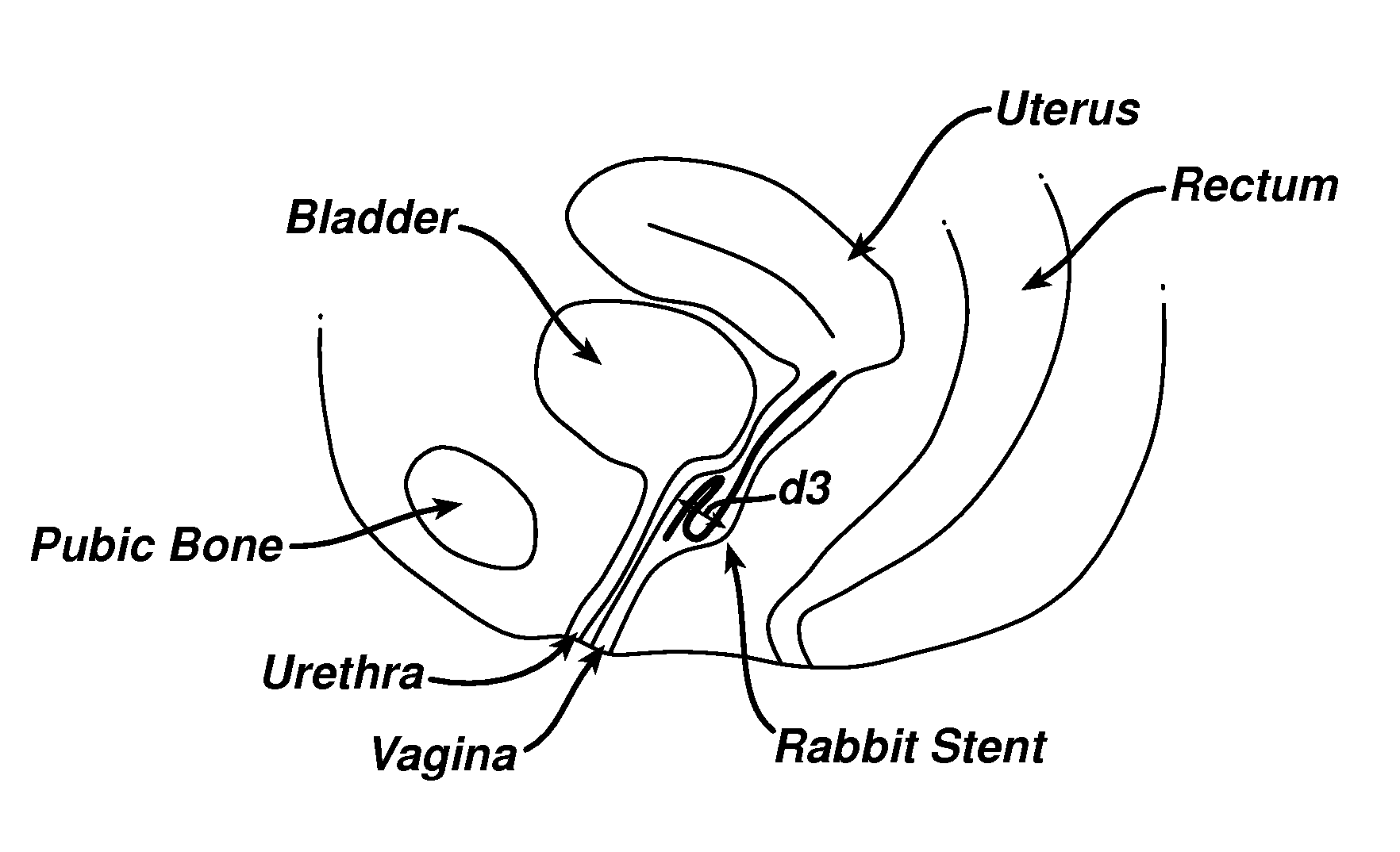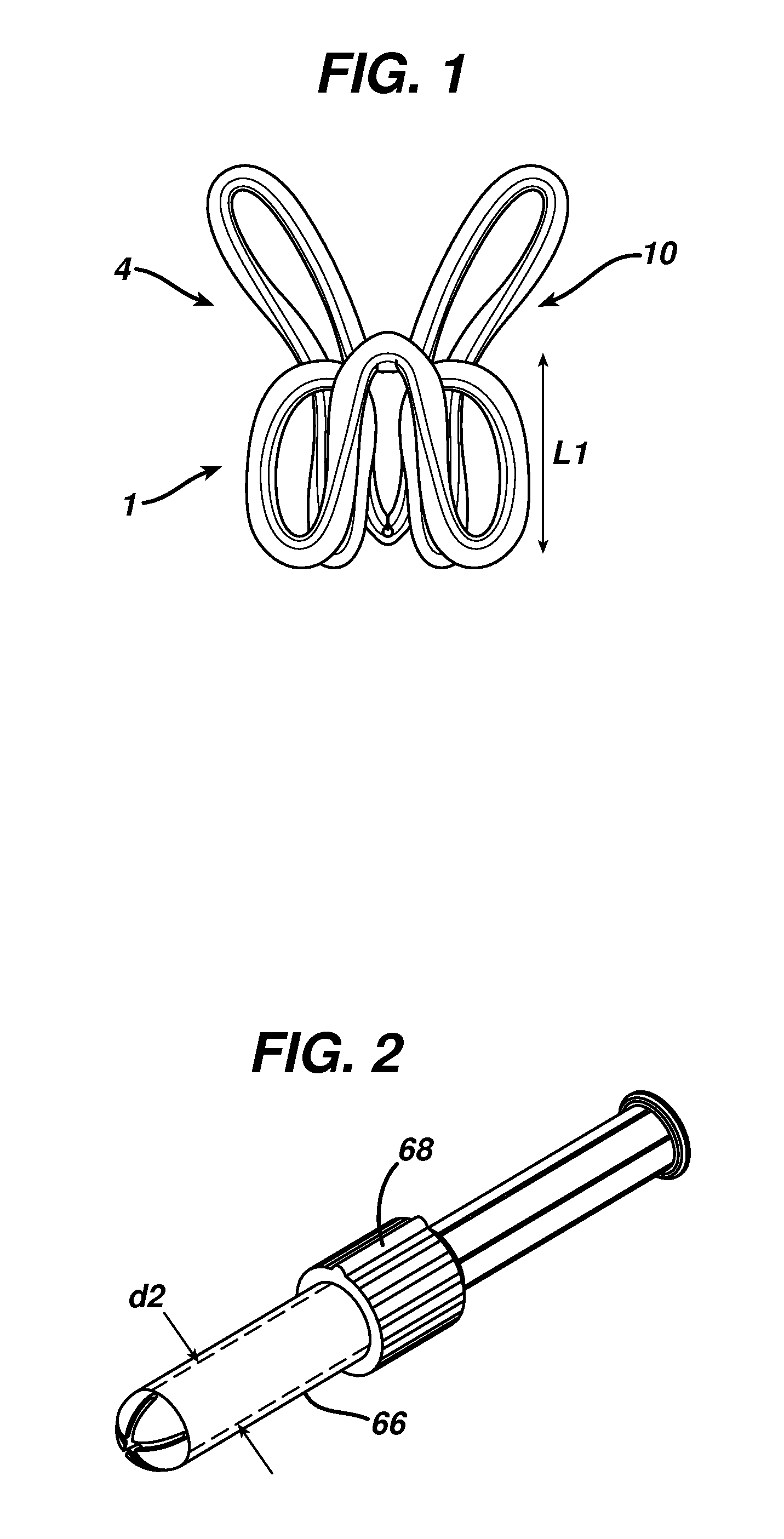Method for treating urinary incontinence
a urinary incontinence and urinary incontinence technology, applied in the field of urinary incontinence treatment, can solve problems such as urinary incontinence stress, and achieve the effect of improving urinary incontinence and reducing urinary incontinen
- Summary
- Abstract
- Description
- Claims
- Application Information
AI Technical Summary
Problems solved by technology
Method used
Image
Examples
example 1
Rabbit Flat Pessary
[0061] Approximately 1 foot of straightened and etched SE508 wire, 0.0315″ diameter was obtained. The tool 100 pictured in FIG. 11 was made using conventional techniques known in stent art. In a smooth upswing, the wire was wrapped around the pins in the following order to create the pattern: P7, P3, PLCC, P3, P6 CC, P3, P6, P4, P8 CC, P5, P8, P5, P2 CC, P5, P7, PLCC, P3, P7 (the wrapping was clockwise, unless indicated by “CC”). The zigzag wrapping pattern was smoothly discontinued and the final end of the wire was poked through holes in the fixture to secure it. A large hose clamp was wrapped around the fixture, over the zigzag portion. The clamp was tightened to keep the wires in position, but not so much as to compress the wires to the surface of the fixture. The wound wire was heat treated on the fixture for 3 minutes in a 505 C (calibrated) salt pot, then quenched with water. The heat-treated wire was removed from the fixture by unwinding it. The wire was t...
example 2
Flower Flat Pessary
[0063] Approximately 1 foot of straightened and etched SE508 wire, 0.0315″ diameter was obtained. The tool 100 pictured in FIG. 11 was made using conventional techniques known in stent art. In a smooth upswing, the wire was wrapped around the pins in the following order to create the pattern: P6, P3, PLCC, P3, P6, P4, P7, P6, P3, PLCC, P3, P6, P4, P7, P5, P2 CC, P5, P7, P4, P6, P3, P1CC, P3, P5, P2 CC, P5, P7, P4, P6, P3, P1CC, and P3. For a two-wire device, the pattern was repeated. The starting point may be adjusted to move the wire ends to a different location. The zigzag-wrapping pattern was smoothly discontinued and the final end of the wire was poked through holes in the fixture to secure it. A large hose clamp was wrapped around the fixture, over the zigzag portion. The clamp was tightened to keep the wires in position, but not so much as to compress the wires to the surface of the fixture. The wound wire was heat treated on the fixture for 3 minutes in a ...
example 3
Multi-Wire Flower Pessary
[0064] The level of severity of incontinence varies greatly from woman to woman and changes throughout a woman's life. Mechanically, this level is determined by the support of the pelvic floor musculature. When this muscle system is weakened, the urethra does not properly close when intra-abdominal pressure is exerted onto the bladder. In order to address the various levels of support of the pelvic floor musculature, there are three pressure levels of the device: Pressure 1 (for women who need minimal amount of support), Pressure 2 (for moderate support), and Pressure 3 (for women who need the greatest support).
[0065] To test this concept, the device of Example 2 was reproduced in these three different pressure levels: Pressure 1 was formed with two wires generally as described above in Example 2; Pressure 2 was formed with three wires; and Pressure 4 was formed with four wires.
PUM
 Login to View More
Login to View More Abstract
Description
Claims
Application Information
 Login to View More
Login to View More - R&D
- Intellectual Property
- Life Sciences
- Materials
- Tech Scout
- Unparalleled Data Quality
- Higher Quality Content
- 60% Fewer Hallucinations
Browse by: Latest US Patents, China's latest patents, Technical Efficacy Thesaurus, Application Domain, Technology Topic, Popular Technical Reports.
© 2025 PatSnap. All rights reserved.Legal|Privacy policy|Modern Slavery Act Transparency Statement|Sitemap|About US| Contact US: help@patsnap.com



